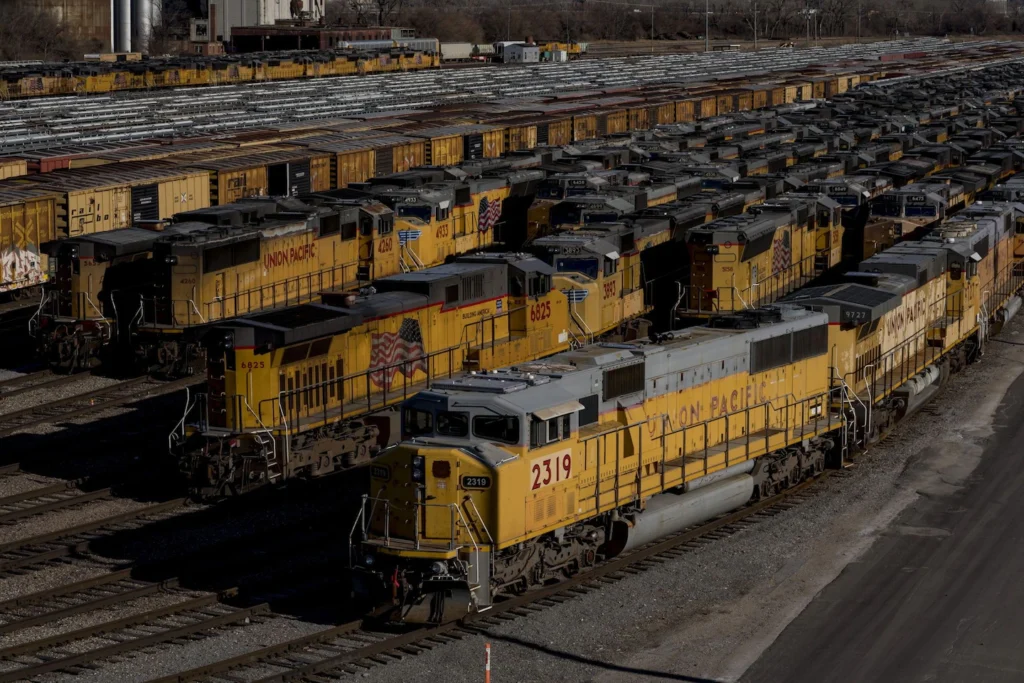
The last time a rail labor loggerhead devolved into a strike was in 1991, and the walkout lasted about a day. Congress resolved the conflict with a bill approved late at night, forcing aides to wake up President George Bush to sign it after 1 a.m. If the two sides can’t come to an agreement before Friday, the bigger question is whether Congress will take the safe route and adopt the board’s plan as-is or take a political risk to add changes that would favor the unions. At least 10 Republican senators will have to get on board to put an end to a strike or lockout.
Surprisingly, the impasse isn’t over wage increases. Work rules for engineers and conductors, the two largest groups of rail workers that haven’t reached an agreement with management, are the main sticking point. Nine other unions that represent workers at rail yards, mechanic shops and other areas have reached accords based on the board’s plan of a 24% pay increase over five years and a $5,000 bonus.
The railroads want flexible work hours to keep trains running. The unions that represent train crews are digging in against attendance policies that require them to report to work on 90 minutes notice. Engineers and conductors complain that they get stuck out on the road and that time staying in a hotel doesn’t boost their pay. Since the pandemic hit in March 2020, the railroads have struggled to hire and retain workers.
It’s not clear whether this rail worker shortage has more to do with attendance policies designed to bolster efficiency or with the nation’s massive shift of attitude toward work that resulted from Covid-19’s disruption of lives. It could be both, but the result is the same: Worker morale is low, and people aren’t lining up for railroad jobs.
If Congress were to intervene and adopt the board’s plan, which doesn’t address the work-rule issues, the labor shortage and low employee morale will most likely continue. If lawmakers adopt some work-rule changes, railroads will seek to pass that extra cost to customers. The railroads are committed to operating margin targets with Wall Street and will get hammered if they back away from those lofty profit goals.
There should be little doubt that the White House deems the US freight railroads as too important to fail, and the Railway Labor Act gives Congress the power to resolve the conflict unlike other disputes with unionized employees, such as dockworkers. A rail shutdown would cost the economy more than $2 billion a day, according to the Association of American Railroads. Trade groups from grain processors to chemical producers are bombarding Congress with letters warning that a strike would cripple their supply chains.
The effects are already being felt as the railroads move to secure hazardous cargo and prevent it from being stranded on the tracks. As the Friday deadline fast approaches, railroads will stop accepting cargo to avoid a pileup of rail cars and huge traffic jams after the dispute is resolved.
A lot of criticism has been aimed at precision scheduled railroading, or PSR, which is an operating system that gained fame with Canadian railroads and then was adopted by most US railroads beginning in 2017. The system, which emphasizes moving rail cars as soon as they come and not waiting to build trains with rail cars of the same type and destination, makes sense. It also requires customers to adhere to schedules for picking up and dropping off rail cars. Problems arose when railroads used the efficiency gains to park locomotives, shut down switching yards and reduce employees. Profit margins jumped, but service sputtered when the networks hit snags, such as bad weather or a derailment. PSR would work well if the railroads were staffed and equipped more robustly.
With more workers, the railroads could be more flexible on attendance policies that have upset employees, causing some to quit and making it harder to recruit new ones. The trade-off is clear: Profit margins would decline from record highs, but the relationship with employees could be reset. Here’s a novel thought: Management and employees could work more as partners instead of adversaries to improve rail performance.
As it stands, both train crews and customers are angry. The latter has complaints about poor service even as the railroads keep raising prices. The rail regulator, the Surface Transportation Board, has taken notice of the unhappy rail constituents and has accelerated moves to streamline challenges on rail rates and to increase competition by giving shippers greater ability to have rail cars switched to another railroad. The railroads oppose both issues but have little goodwill from customers or workers to fall back on.
For now, it’s difficult to handicap who will get the upper hand when this rail labor contract is resolved, especially if it’s left up to Congress. If lawmakers impose the Presidential Emergency Board’s plan with no changes and President Joe Biden signs the bill, the railroads can claim victory. But they will still have to grapple with a disgruntled workforce and service issues. If the Democrat-controlled Congress pushes for changes on work rules that favor the unions, it will be harder to bring 10 Republican senators on board to break a filibuster.
Whatever the outcome, a labor deal will get done — negotiated or imposed — because it would be a disaster for the economy if Congress were to allow a strike or lockout to bring the supply chain to a screeching halt.
This column does not necessarily reflect the opinion of the editorial board or Bloomberg LP and its owners.
Thomas Black is a Bloomberg Opinion columnist covering logistics and manufacturing. Previously, he covered U.S. industrial and transportation companies and Mexico’s industry, economy and government.
More stories like this are available on bloomberg.com/opinion

